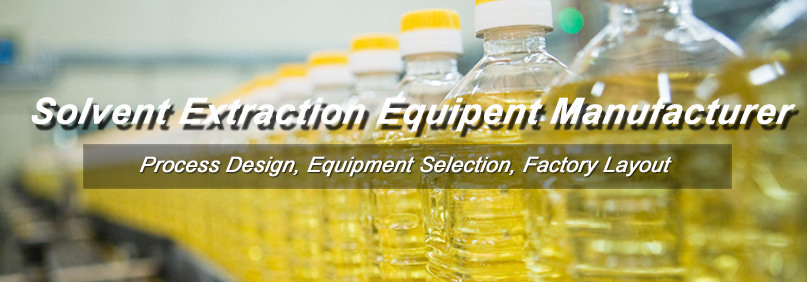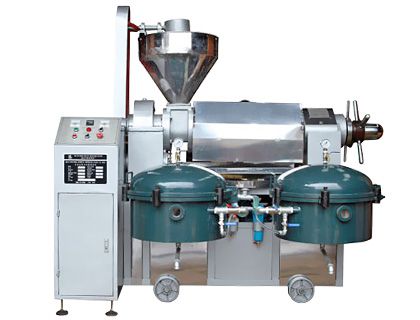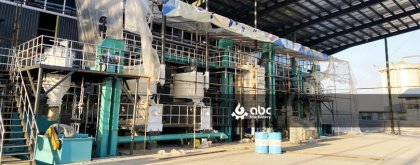Leaching method for oil production refers to the application of extraction principle, select a kind of organic solvent that can dissolve the oil, through contact with the oil (soaking or spraying), so that the oil in the oil-bearing material is extracted. Compared with oil pressing method, the leaching method has the advantages of lower residual oil rate (higher oil yield), lower labor intensity, better working environment and better quality of the meal, but with much investment cost. This oil extraction method has been widely used in edible oil processing industry. (Read more: Mini Solvent Extraction Plant Cost >>)

Setup Your Own Solvent Extraction Plant for Edible Oil Business
Development History of Solvent Extractor
In 1914, the German Hermann Bollmann invented the basket hopper solvent extraction equipment. In July 1916, Bollmann built the Hansa Muehle continuous solvent extraction plant for soybeans oil production on the Rhine. Allis-Chalmers Manufacturing Company and V.D. Anderson Company introduced the upright basket hopper solvent extraction plant from Germany. 1940 French Oil and Fat Equipment Company and Blaw-Knox Company modified Bollmann's basket hopper solvent extraction equipment and developed a flat-turn solvent extraction from the flat-turn basket hopper percolator type. In 1947, Crown Company received a patent from Iowa State University in 1947 and in 1948 the American Crown Steel Works began production of leachers and around the same time De Smet in Belgium also entered the field of solvent extraction.
Solvent extractor has been developed over a history of nearly 100 years and currently the largest solvent extraction equipment can deal with a capacity of 10,000 tonnes/day per unit. At present, continuous solvent extractor are widely used. The most commonly used solvent extraction machines are classified according to the main structural features of the equipment and the mode of operation as flat rotary, sliding frame bucket, ring drag chain, crawler and so on.
Solvent Extractor Types for Edible Oil Production
- Rotary Extractors
Since the introduction of the Rotcel flat solvent extractor in the USA in 1940, the original low efficiency pure percolation solvent extractor with false bottom, 12 leaching grid structure has been developed into a variety of high efficiency flat solvent extractors through continuous improvement and development. At present, the widely used solvent extractors are large spray mixed leachers and they are different in structure. Although the structure of each has its own characteristics, but they have in common: compact structure, high material layer (1.2 ~ 3.5m), reliable operation, low power consumption, high concentration of mixed oil, and suitable for a variety of oil materials in addition to powder degree material billet.
- Sliding Cell Extractor
The horizontal grate bottom hopper (Lurgi SC), also known as the "sliding hopper" (SC), is a new type of high efficiency leacher developed by Lurgi. The main working part is the hopper, which is no longer drawn by an open mesh belt, but slides on a fixed grate bottom, driving the billet through the leaching operation. The bottom of the grate is divided into two layers, which are assembled by a number of "V" grate bars with a gap width of 0.8~1.2mm. The hopper is actually formed by a number of (40~60) specially shaped partitions to form a cavity to store the material. The bottom of the frame moves horizontally on the bottom of the grate. At the same time, when the upper hopper moves to the end discharge opening, the material is dropped into the lower hopper by gravity and then, through the drive pin wheel, the hopper is turned over to the lower level and continues to move horizontally. The hopper continues to move horizontally until the material is leached out against the flow, drained to the meal, and then turned to the upper layer to enter a new leaching process. At the bottom of the grate there is an oil collection hopper at intervals of 4 to 6 frame hoppers, with a total of 6 to 8 circulation pumps for spraying circulation.
- Perforated Belt Extractor
The main components of the De Smet tracked leachers include: sealing winches, storage boxes and level control devices: a conveyor belt (track) that runs in a circle and gradually inclines upwards from feed to meal; a closed housing with a level control scraper at the feed end; a toggle tooth at the meal end: main and driven sprockets (4) and drive system: oil mixing circulation pumps (9), spray pipes (9) and oil collection tanks, meal discharge winches and other components. (9) as well as the oil collection tank, the meal discharge winch and other parts of the composition. The effective length of the chain belt leaching is 16~22m, and the line speed of the chain belt is 6~15m/h.
- Rectangular Loop Extractor
In 1947 Crown agreed with Iowa State University and DuPont to use their designs, patents and experience to develop a commercial leaching plant for oil production. A wide range of models and sizes have been developed. The material first enters the storage box at the top of the leachers and is driven by the scraper chain frame towards the spraying leaching section (straight section) and is sprayed several times at the same time before entering the lower layer through the curved section to continue leaching.
If you want to know more information about types of solvent extraction machines, just contact us directly, our professional engineers will get back to you very soon!
Solvent Extraction Plant Project by ABC Machinery - Low Cost & High Efficiency

Solvent Extraction Plant Setup in Zambia
As a leading oil mill machinery supplier, ABC Machinery boosts strong capacity to undertake large scale solvent extraction plant for edible oil production. We have built a complete solvent extraction plant in Zambia for soybean oil processing and mini solvent extraction plant in Afganistan for cottonseed oil extraction, if you are interested in knowing more about the equipment list and exact cost, just contact us to get the project report!
We receive enquiries in English, Español (Spanish), Русский язык (Russian), Français (French) and العربية (Arabic).Our professional team will reply to you within one business day.Please feel free to contact us!











 Screw Oil Press
Screw Oil Press Small Oil Mill Plant
Small Oil Mill Plant Small Oil Refinery
Small Oil Refinery Automatic Oil Press
Automatic Oil Press Multifunction Oil Press
Multifunction Oil Press Hydraulic Oil Press
Hydraulic Oil Press


![[Presidential Visit] Zimbabwe 30 Tons/Day soybean oil plant for Extraction and Refinery Was Successfully Completed](/uploads/allimg/soybean-oil-plant-press-refine-business-lp.jpg)

